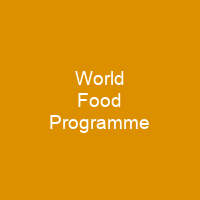The World Food Programme is the food-assistance branch of the United Nations. Founded in 1961, it is headquartered in Rome and has offices in 80 countries. As of 2019, it served 97 million people in 88 countries, the largest since 2012. Two-thirds of its activities are conducted in conflict zones.
About World Food Programme in brief

In October 2020, WFP had 19,660 staff. The agency is also a major provider of direct cash assistance and medical supplies, and provides passenger services for humanitarian workers. The Logistics Cluster is an Inter-Agency Standing Committee humanitarian coordination mechanism whose primary role is supporting emergency responses. It was established by UN General Assembly resolution 46182 in December 1991 and extended in the Humanitarian Reform of 2005, with new elements adopted to improve capacity, predictability, accountability, leadership and partnership. It also acts as a \”provider of last resort\” offering common logistics services when the humanitarian response is needed.
You want to know more about World Food Programme?
This page is based on the article World Food Programme published in Wikipedia (as of Dec. 14, 2020) and was automatically summarized using artificial intelligence.







